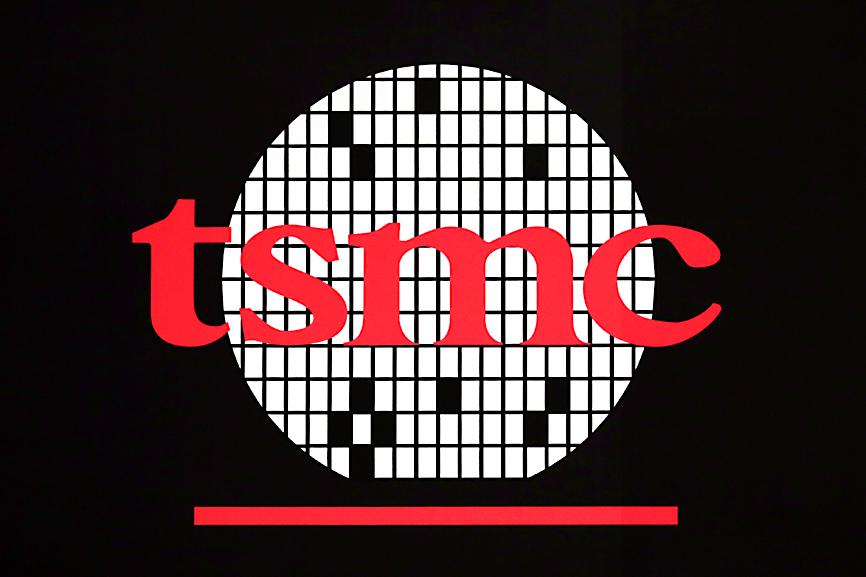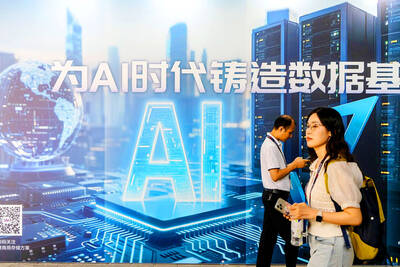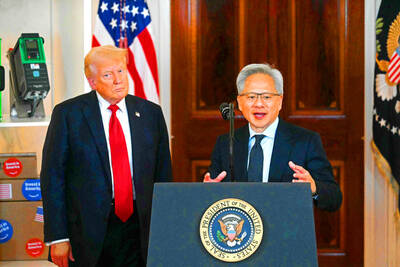Taiwan Semiconductor Manufacturing Co (TSMC, 台積電) plans to allocate a larger portion, or about 9 percent, of its total revenue this year to research and development (R&D) on cutting-edge technologies to safeguard its technological lead amid intensifying competition, the chipmaker’s annual report said.
That could bring TSMC’s R&D budget to more than NT$110 billion (US$3.65 billion) if it reaches its goal of growing revenue by more than 15 percent annually this year — to at least NT$1.23 trillion.
This year’s spending would be a 20 percent increase over last year’s record-high R&D expenditure of NT$91.42 billion.

Photo: EPA-EFE
The bulk, or 70 percent, of this year’s R&D budget is to be spent on advanced technologies, including the 3 nanometer (nm) technology platform and applications, next-generation technologies and 3D IC for system-in-package modules, the report said.
TSMC, a pioneer in the semiconductor industry, said that it began R&D on 2nm technology last year, as it targets 5G-related applications and high-performance-computing devices.
“To maintain and strengthen TSMC’s technology leadership, the company plans to continue investing heavily in R&D,” the report said.
“The markets for TSMC’s foundry services are highly competitive. TSMC competes with other foundry service providers, as well as with a number of integrated device manufacturers,” the company said, referring to the competition it faces.
If TSMC is unable to effectively take on these new and aggressive competitors when it comes to technology, manufacturing capacity, product quality and customer satisfaction, it risks losing customers to these new contenders, the report said.
TSMC, which commands a 52 percent share of the world’s foundry market, competes primarily with Samsung Electronics Co for advanced technology orders, while its Chinese rival Semiconductor Manufacturing International Corp (SMIC, 中芯) is positioning itself to take a bite out of TSMC’s share in China.
TSMC last week said that it plans to increase production of 3nm technology in the second half of 2022, which would make it the foremost foundry offering the technology.
The chipmaker’s report also warned of possible negative effects resulting from the COVID-19 pandemic, saying that the coronavirus might interrupt the global semiconductor supply chain and disrupt some of its suppliers.
There could be downward adjustments in customer demand or production delays for TSMC products, due to forced closures, or partial operations, at factories and offices, the report said.
Due to fallout from the pandemic, the chipmaker expects the global semiconductor industry to see stagnant revenue this year, at best, it said, adding that the industry is expected to grow at a compound annual growth rate of 5 percent between last year and 2024.
The chipmaker also disclosed that company chairman Mark Liu (劉德音) and CEO C.C. Wei (魏哲家) received NT$293 million in compensation apiece last year, accounting for 0.085 percent of net profits last year, the report showed.
Last year, the company paid NT$1.545 billion in compensation to its high-ranking executives.

Taiwan Semiconductor Manufacturing Co (TSMC, 台積電) last week recorded an increase in the number of shareholders to the highest in almost eight months, despite its share price falling 3.38 percent from the previous week, Taiwan Stock Exchange data released on Saturday showed. As of Friday, TSMC had 1.88 million shareholders, the most since the week of April 25 and an increase of 31,870 from the previous week, the data showed. The number of shareholders jumped despite a drop of NT$50 (US$1.59), or 3.38 percent, in TSMC’s share price from a week earlier to NT$1,430, as investors took profits from their earlier gains

AI TALENT: No financial details were released about the deal, in which top Groq executives, including its CEO, would join Nvidia to help advance the technology Nvidia Corp has agreed to a licensing deal with artificial intelligence (AI) start-up Groq, furthering its investments in companies connected to the AI boom and gaining the right to add a new type of technology to its products. The world’s largest publicly traded company has paid for the right to use Groq’s technology and is to integrate its chip design into future products. Some of the start-up’s executives are leaving to join Nvidia to help with that effort, the companies said. Groq would continue as an independent company with a new chief executive, it said on Wednesday in a post on its Web

CHINA RIVAL: The chips are positioned to compete with Nvidia’s Hopper and Blackwell products and would enable clusters connecting more than 100,000 chips Moore Threads Technology Co (摩爾線程) introduced a new generation of chips aimed at reducing artificial intelligence (AI) developers’ dependence on Nvidia Corp’s hardware, just weeks after pulling off one of the most successful Chinese initial public offerings (IPOs) in years. “These products will significantly enhance world-class computing speed and capabilities that all developers aspire to,” Moore Threads CEO Zhang Jianzhong (張建中), a former Nvidia executive, said on Saturday at a company event in Beijing. “We hope they can meet the needs of more developers in China so that you no longer need to wait for advanced foreign products.” Chinese chipmakers are in

POLICY REVERSAL: The decision to allow sales of Nvidia’s H200 chips to China came after years of tightening controls and has drawn objections among some Republicans US House Republicans are calling for arms-sale-style congressional oversight of artificial intelligence (AI) chip exports as US President Donald Trump’s administration moves to approve licenses for Nvidia Corp to ship its H200 processor to China. US Representative Brian Mast, the Republican chairman of the US House Committee on Foreign Affairs, which oversees export controls, on Friday introduced a bill dubbed the AI Overwatch Act that would require the US Congress to be notified of AI chips sales to adversaries. Any processors equal to or higher in capabilities than Nvidia’s H20 would be subject to oversight, the draft bill says. Lawmakers would have